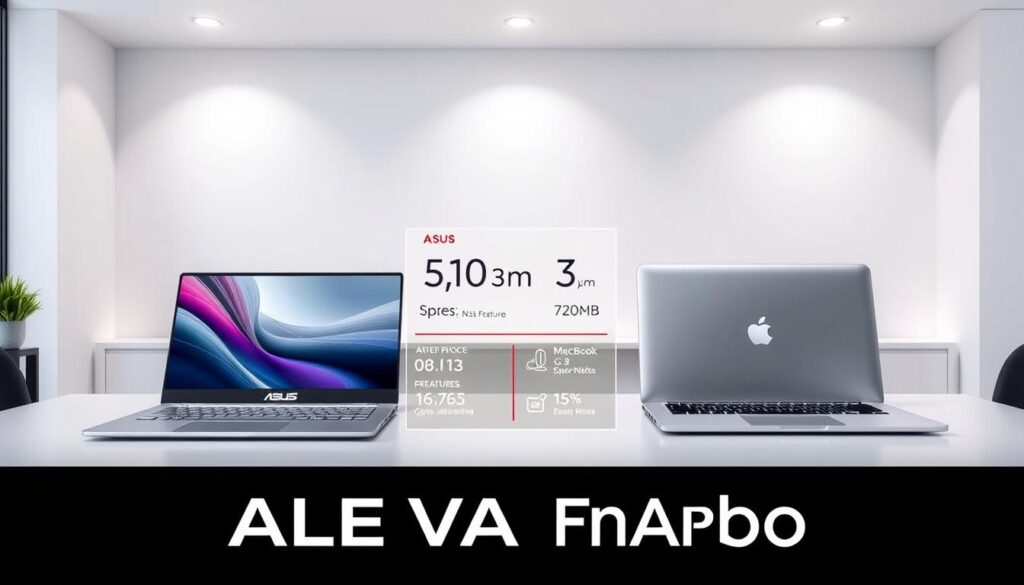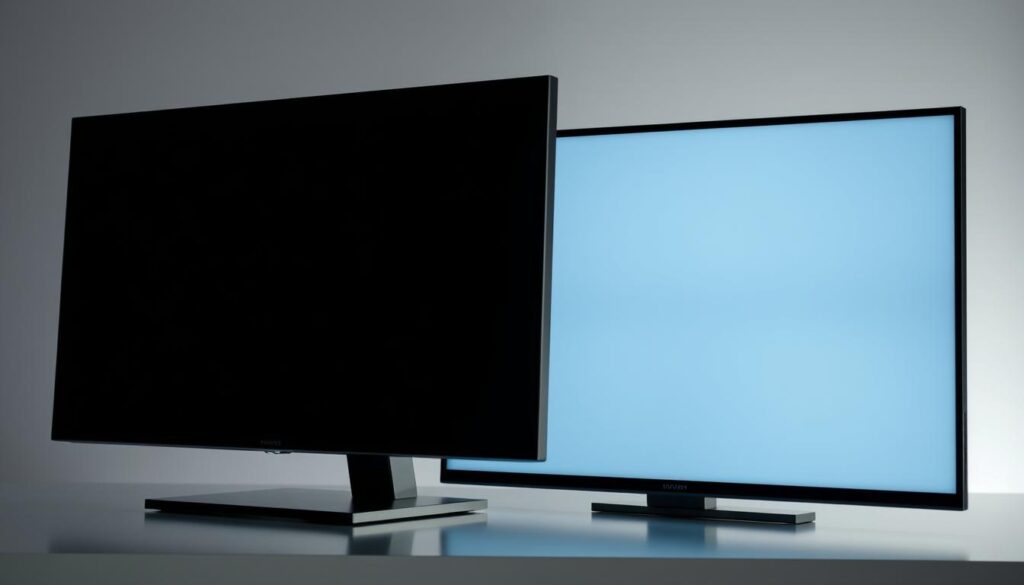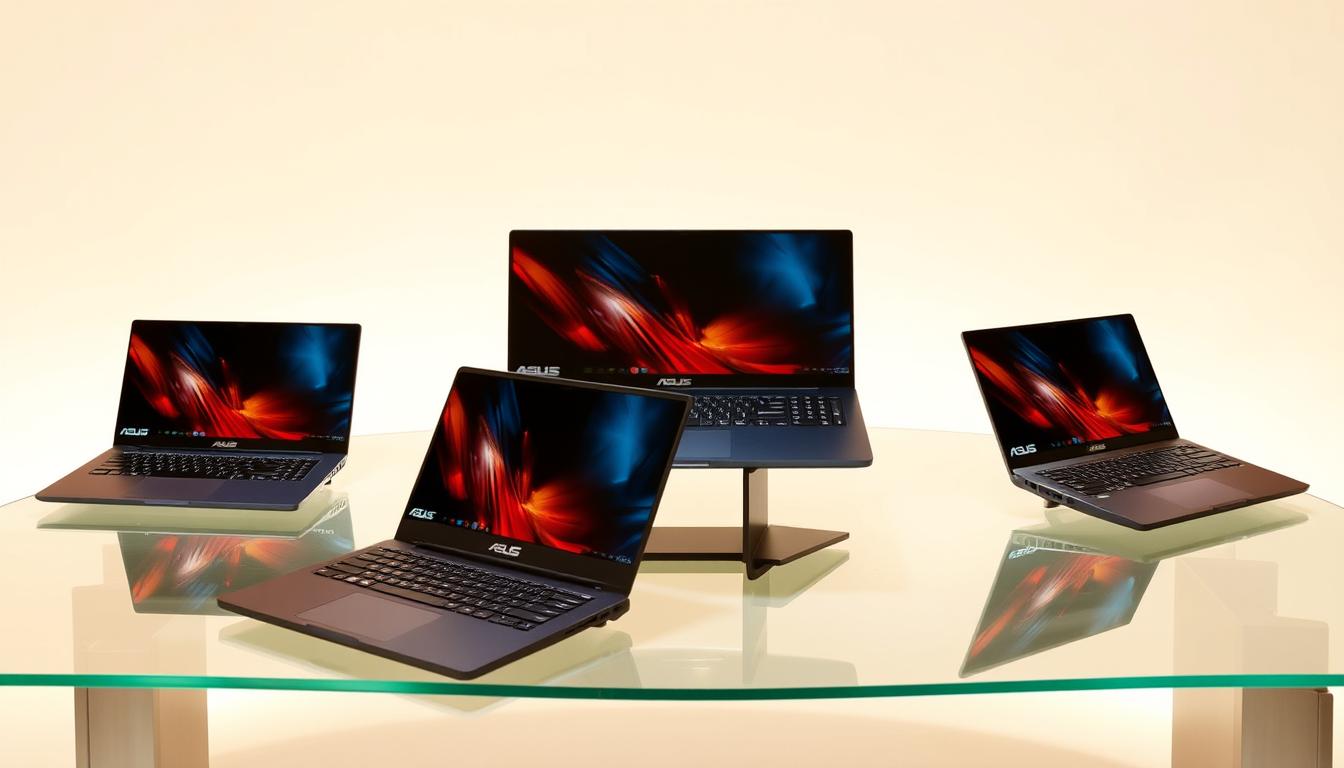Modern professionals need devices that balance power with portability. While Apple’s computers dominate conversations about premium tech, several Windows-based machines now offer comparable engineering at accessible price points. Models like the ProArt P16 (H7606) demonstrate this shift, packing AMD’s Ryzen AI 9 HX 370 processor and 32GB RAM into a 4.08-pound frame.
These devices excel in specialized tasks. The ProArt series targets creators with its 4K OLED touchscreen and Nvidia RTX 4070 GPU, while the ROG Zephyrus G14 combines a 3K OLED display with gaming-grade Nvidia 4060 graphics. Both deliver over 10 hours of battery life, matching Apple’s endurance claims.
What sets these laptops apart? They maintain sleek designs without sacrificing practical features. Multiple USB ports, HDMI outputs, and SD card readers address common workflow needs better than many MacBooks. For Indian buyers, this versatility matters when handling diverse file formats or external devices.
Key Takeaways
- Windows laptops now rival MacBooks in build quality and processing capabilities
- High-end models support creative workflows with professional-grade GPUs and color-accurate OLED screens
- Superior connectivity options simplify multitasking compared to Apple’s minimalist approach
- Competitive pricing makes premium features accessible across budget ranges
- Battery performance matches or exceeds Apple’s advertised benchmarks
Introduction: Discovering ASUS Alternatives to the MacBook
Tech enthusiasts increasingly prioritize devices that blend style with substance. While premium notebooks often dominate discussions, Windows-powered options now challenge traditional preferences through thoughtful engineering. Take the Zenbook S 14 (2025): its 11mm aluminum chassis houses an Intel Core Ultra 7 processor and 15-hour battery life, proving thin profiles can deliver serious power.
ASUS demonstrates how premium materials meet practical functionality. The Zenbook 14 OLED weighs just 2.8 pounds yet packs a Ryzen 7 processor and 17-hour endurance. These machines showcase how modern engineering balances portability with professional-grade performance.
| Model | Display | Battery Life | Weight |
|---|---|---|---|
| Zenbook S 14 | 14″ 2.8K OLED | 15 hours | 1.2kg |
| Zenbook 14 OLED | 14″ FHD+ OLED | 17 hours | 2.8 lbs |
What makes these devices stand out? Their connectivity options cater to real-world needs. Dual USB-C ports, HDMI outputs, and SD card readers simplify workflows better than many minimalist competitors. For Indian users juggling multiple peripherals, this flexibility becomes crucial.
The emphasis on visual quality further bridges the gap between operating systems. Both models feature OLED screens with 120Hz refresh rates, offering vibrant colors that rival Apple’s Liquid Retina displays. This attention to detail positions them as viable options for creatives and professionals alike.
Why Consider ASUS Alternatives to the MacBook?
Choosing the right device requires balancing performance with practical needs. Many premium options now deliver professional-grade capabilities without the steep costs. Take the Zenbook 14 OLED – starting at $759, it undercuts competitors by 40% while offering vibrant displays and versatile connectivity.

Key Benefits and Value Proposition
These devices shine in three areas. First, their price-to-performance ratio lets users access OLED screens and robust processors at mid-range budgets. Second, they retain crucial ports that simplify workflows:
| Feature | Zenbook 14 OLED | Standard Premium Model |
|---|---|---|
| Starting Price | $759 | $1,299+ |
| Ports | USB-A, HDMI, SD Card | USB-C Only |
| OS | Windows 11 | macOS |
Third, Windows compatibility unlocks specialized software for engineering, data analysis, and gaming. As one Mumbai-based designer notes:
“Having HDMI and SD slots lets me present work directly from my device – no dongle jungle.”
Ideal Users and Workflows
Four groups gain most from these machines:
- Business teams needing Excel macros or enterprise security tools
- Content creators requiring color-accurate OLED displays
- Students managing budgets but wanting premium build quality
- Gamers seeking RTX graphics without overspending
With configuration options ranging from Ryzen 5 to Core i7 processors, users can tailor devices to their exact productivity demands.
Design and Build Quality of ASUS Laptops
Attention to detail elevates modern computing devices beyond basic functionality. Manufacturers now blend artistic vision with industrial precision, creating tools that inspire confidence during daily use. The result? Machines that feel like extensions of their users’ creative intent.
Sleek and Modern Aesthetics
Today’s premium devices showcase refined visual language through precision-cut aluminum bodies and minimalist profiles. The Zenbook series demonstrates this philosophy with 2.8-pound frames featuring diamond-cut edges and hidden hinge mechanisms. Space gray finishes mirror professional environments while reducing visible fingerprints.
Flagship models employ CNC machining techniques typically reserved for luxury goods. This process ensures seamless alignment between components – no creaking panels or uneven gaps. One Bengaluru-based architect observes: “The clean lines make clients perceive my work as more polished when presented from these devices.”
Durability and Material Quality
Rigorous testing protocols ensure longevity under demanding conditions. Keyboards withstand 20 million keystrokes, while hinges endure 30,000 open-close cycles – surpassing military-grade durability standards. The ProArt P16’s magnesium-aluminum alloy chassis combines lightweight design (4.08 lbs) with exceptional torsional rigidity.
Three elements define superior construction:
- Reinforced corners absorb impact from accidental drops
- Anti-fingerprint coatings maintain professional appearance
- Vapor chamber cooling prevents performance throttling
These engineering choices result in devices that withstand India’s diverse climate conditions while maintaining peak performance. From humid coastal regions to dusty inland cities, the build quality ensures reliable operation year after year.
Performance and Processor Capabilities
Processing power drives modern workflows, whether rendering 4K videos or compiling complex code. Today’s devices tackle these demands through advanced chip architectures that balance raw speed with intelligent resource management.
Intel Core Ultra: Efficiency Meets AI
The Intel Core Ultra 7 258V in Zenbook models introduces dedicated neural processors for AI tasks. This design reduces power consumption by 25% compared to previous generations while handling photo editing and data analysis faster. Users gain extended battery life without compromising on multitasking capabilities.
AMD Ryzen: Multi-Core Muscle
AMD’s Ryzen AI 9 HX 370 in the ProArt P16 excels in parallel processing. With 12 cores and 24 threads, it renders 3D models 40% quicker than standard workstation chips. Paired with Nvidia RTX graphics, this setup handles everything from video timelines to CAD simulations.
Thermal management ensures sustained performance during long sessions. Vapor chamber cooling in ROG Zephyrus models keeps temperatures 15°C lower under load compared to conventional systems. This allows the Ryzen 9 8945HS processor to maintain peak clock speeds during marathon gaming or rendering tasks.
| Processor | Key Feature | Use Case |
|---|---|---|
| Core Ultra 7 | AI Acceleration | Productivity Apps |
| Ryzen AI 9 | 24 Threads | Content Creation |
| Ryzen 9 8945HS | High Clock Speeds | Gaming/VR |
These innovations prove that modern chips deliver more than just brute force. They adapt to user needs – prioritizing battery life during meetings or unleashing full power when plugged into creative workflows.
Battery Life and Portability Comparison
Mobility demands in today’s workforce require devices that keep pace without constant charging. Modern engineering delivers all-day endurance across productivity and creative workflows, with some models pushing past 17 hours of active use.
The Zenbook 14 OLED leads this charge, lasting through back-to-back meetings and editing sessions on a single charge. Its 17-hour capacity stems from intelligent power management that adjusts screen brightness and CPU usage based on task requirements.
| Model | Battery Life | Weight |
|---|---|---|
| Zenbook S 14 | 15 hours | 2.8 lbs |
| ProArt P16 | 12h 59m | 4.08 lbs |
| ROG Zephyrus G14 | 10 hours | 3.64 lbs |
Fast charging solutions address India’s frequent power fluctuations. The Zenbook S 14 regains 70% capacity in 49 minutes – enough for six additional hours of spreadsheet work or video calls. This feature proves vital for professionals commuting between Delhi’s business hubs.
Portability extends beyond numbers. The ROG Zephyrus combines gaming-grade hardware with a 3.64-pound frame, while the ProArt P16 maintains studio-grade performance at airport-friendly dimensions. As Mumbai-based photographer Arjun Kapoor notes: “I shoot weddings all day without hunting for outlets – the battery life matches my hectic schedule.”
These engineering choices make devices adaptable to diverse Indian environments. From Chennai’s humidity to Jaipur’s summer heat, optimized thermal designs ensure consistent performance without compromising battery longevity.
Display Quality and Screen Technology
Visual clarity transforms how users interact with digital content. Modern devices now deliver cinematic experiences through advanced panel technologies that adapt to professional and entertainment needs.

OLED Versus Traditional Displays
OLED screens revolutionize color reproduction with true-to-life accuracy. Unlike LCD panels that use backlights, each pixel emits its own light – achieving infinite contrast ratios and deeper blacks. This matters for Delhi-based video editor Priya Sharma: “Editing night scenes became easier when shadows stopped looking washed out.”
| Feature | OLED | LCD | Advantage |
|---|---|---|---|
| Contrast Ratio | 1,000,000:1 | 1,500:1 | Richer Depth |
| Response Time | 0.2ms | 5ms | Smoother Motion |
| Color Coverage | 100% DCI-P3 | 72% NTSC | Professional Accuracy |
Resolution and Refresh Rate Insights
Higher resolutions like 4K (3840×2400) make text crisp and images razor-sharp. Combined with 120Hz refresh rates, scrolling through timelines feels fluid – ideal for Mumbai animators handling 60fps footage.
Three display tiers cater to different needs:
- 2.8K OLED: Balances detail with battery efficiency
- 3K OLED: Enhances HDR content visibility
- 4K Touchscreen: Precision for digital artists
These innovations address India’s growing demand for portable studios. Whether reviewing architectural plans in Chennai or streaming shows in Kolkata, users gain theater-quality visuals without bulky equipment.
Connectivity and Multi-Port Availability
Constant dongle dependency plagues modern workflows, but Windows laptops now solve this through thoughtful engineering. The Zenbook S 14 exemplifies this approach with dual USB-C ports, HDMI output, and SD card slot – all packed into its slim frame.
These devices simplify connections for Indian professionals. Architects transfer site photos via SD readers, while presenters plug directly into projectors using HDMI. As Mumbai-based videographer Neha Patel notes: “My workflow needs three devices connected simultaneously – these ports let me work anywhere without adapters.”
| Feature | Zenbook 14 OLED | Premium Competitor |
|---|---|---|
| USB-A Ports | 2 | 0 |
| HDMI Version | 2.1 | Requires Adapter |
| Audio Jack | 3.5mm | Wireless Only |
Key advantages become clear in office environments. The Zenbook series supports legacy printers through USB-A while streaming 4K video via HDMI. This eliminates the need for bulky docking stations during client meetings.
Thunderbolt 4 capabilities in USB-C ports enable rapid data transfers – moving 100GB of design files takes under 3 minutes. Combined with SD card readers, photographers can edit photos directly from cameras without intermediate devices.
This system of connectivity proves vital across India’s diverse tech landscape. From college campuses using older projectors to studios requiring multiple monitors, having the right ports ensures seamless productivity.
Pricing and Value for Money in ASUS Laptops
Smart shoppers recognize when premium features meet reasonable pricing. The Zenbook 14 OLED demonstrates this balance perfectly, starting at $759 with professional-grade specs. At this price point, users gain access to color-accurate OLED screens and robust processors typically reserved for higher-tier devices.
Compare this to competing systems costing 40% more for similar capabilities. The ProArt P16 illustrates this value further at $1,899, packing studio-grade components into a mobile workstation. These machines prove that cost savings don’t require sacrificing build quality or performance.
Three factors drive exceptional value:
- Inclusion of OLED displays in entry-level configurations
- Comprehensive port selections eliminating dongle costs
- Higher default RAM/storage than competing systems
Indian professionals particularly benefit from this pricing strategy. The combination of thermal-efficient designs and local service networks creates a reliable computing experience across climate zones. Whether editing in Mumbai or presenting in Delhi, these laptops deliver premium functionality without premium price tags.
